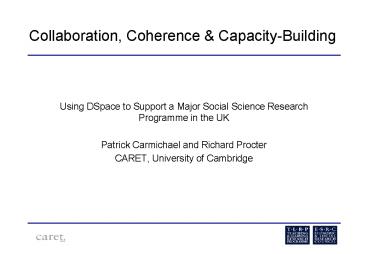Collaboration, Coherence - PowerPoint PPT Presentation
1 / 15
Title:
Collaboration, Coherence
Description:
Sector descriptors based on British Education Thesaurus ... Open Archive Initiative OAI-PMH Interface. The TLRP DSpace OAI Interface: some applications ... – PowerPoint PPT presentation
Number of Views:51
Avg rating:3.0/5.0
Title: Collaboration, Coherence
1
Collaboration, Coherence Capacity-Building
- Using DSpace to Support a Major Social Science
Research Programme in the UK - Patrick Carmichael and Richard Procter
- CARET, University of Cambridge
2
The Teaching and Learning Research Programme
- An eight-year, 30 million programme of Education
Research - Administered by the Economic and Social Research
Council (ESRC) - Charged with supporting and developing education
research in the United Kingdom - Over 40 projects
- Over 300 researchers based in Further and Higher
Education Institutions across England, Wales,
Scotland and Northern Ireland. - Research Fellowships
- Research Capacity Building Activities
- Thematic groups and seminar series
- Outputs include books, special editions of
journals, articles, research briefing and
reports, teaching materials and videos
3
Elements of the TLRP IT Infrastructure
- Programme website
- Programme Information
- Resources for participants and project
administrators - News and Events
- Project Summaries
- Project websites
- Most run by participating institutions
- TLRP hosts some project websites
- Database of individuals, projects and
organisations - Collaboration Environments dotLRN and Sakai
- DSpace
4
Characteristics of the TLRP DSpace
- Single Collection including
- Conference Papers (49)
- Occasional Papers, Research Briefings and Reports
(22) - Books (9)
- Published Articles (20)
- Ready for the RAE!
- Sector descriptors based on British Education
Thesaurus - Descriptive vocabulary developed by TLRP
community - Submission at project or individual level
- Moderation by members of TLRP Directors Team
- Open Archive Initiative OAI-PMH Interface
5
The TLRP DSpace OAI Interface some applications
6
DSpace content as RSS in the Sakai Environment
OAI feed is transformed into RSS feed which then
is aggregated in Sakai
7
Using DSpace to Explore Collaborative Practices
in TLRP Projects
- DSpace provides (through the OAI interface) a
means of observing over time how co-authorship
networks develop within and between the projects
of the TLRP. - Co-authorship is only a proxy for collaboration,
which may take different forms in different
settings - and it may not be the best one. - Large scale studies have been undertaken
- Science (Newman, 2001-4)
- Sociology (Moody, 2004)
- These have established some key approaches and
metrics which can be applied. - But these have been historical analyses, not
live!
8
Bipartite Author-Publication Graph
Vertices represent authors and publications and
arrows represent the relationship 'is an author
of'. Note how author A1, as well as
'single-authoring' publication P1, is also a
co-author of publication P2 with A2 and A3.
9
Author Graph
Vertices represent authors and arrows represent
the relationship 'has co-authored with'. The
lack of this relationship between author A1 and
A4 is evident, as is the isolation of author A5.
With publications removed, the number of times
any author has co-authored with another is not
represented.
10
Fundamental Statistics for the TLRP DSpace
11
A component of the author network
Christie, D., Tolmie, A., Howe, C., Topping, K.,
Thurston, A., Jessiman, E., Livingston, K., and
Donaldson, C. (2004) The impact of collaborative
group work in primary classrooms and the effects
of class composition in urban and rural schools
(TLRP Annual Conference, November 2004)
Howe, C.,Nunes, T.,Bryant, P., and Jafri, S
(2004) 'Intensive quantities why they matter to
mathematics education' (TLRP Annual Conference,
November 2004)
12
A portion of the author network, showing cohesive
subgroups, cliques and isolates
13
The author network a month later showing the
development of a giant component
14
Conclusions and Next Steps
- OAI can be used in many different ways!
- But care needs to be taken when using something
designed for resource discovery for resource
description and in more complex applications. - Careful design of metadata frameworks and
vocabularies and aggregation of metadata records
allows exploration of complex phenomena. - Caution!
- Small dataset as yet
- Cannot be sure we have complete set
- Might need to look at other bipartite graphs, or
at combinations of several. - Just because you can, doesnt mean you should!
15
Thank you!
- Contact Addresses
- patrick_at_caret.cam.ac.uk
- richardp_at_caret.cam.ac.uk
- Websites
- http//www.tlrp.org
- http//www.tlrp.org/dspace































